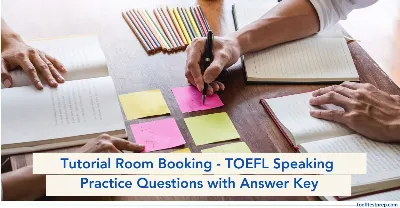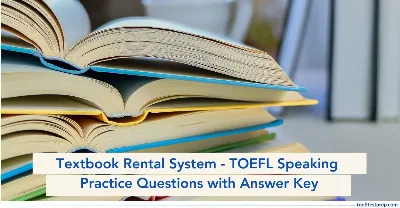Quantum Entanglement - TOEFL iBT® Reading Practice Test

"Improve your TOEFL Reading skills with our practice passage on 'Quantum Entanglement,' crafted to enhance comprehension of advanced physics topics."
Key Highlights
In the TOEFL Reading section, topics like 'Quantum Entanglement' challenge your ability to grasp complex scientific theories. This phenomenon, where particles interact regardless of distance, fascinates scientists and presents significant implications for physics.
Practising passages on 'Quantum Entanglement' helps you develop the skills needed to comprehend challenging scientific texts, identify main ideas, and answer test questions accurately.
Reading Instructions:
- You have 15 minutes to read the following passage and answer all 9 questions related to it.
- Most questions are worth 1 point, but the last question is worth more. The directions indicate how many points you will receive for that specific question.
- The specific section/paragraphs have been provided again with the question for ease of understanding and quick solution.
- Some questions include a word or phrase that is highlighted in the question as well as in the paragraph for quick reference.
Quantum Entanglement
A quantum entanglement is an important event in quantum mechanics, where two or more particles become linked in such a way that the state of one particle instantly affects the state of the other, no matter how far apart they are. This strange relationship was first described by Albert Einstein, Boris Podolsky, and Nathan Rosen in 1935, in what is now called the EPR contradiction. They argued that if quantum mechanics were complete, then linked particles would show connections that classical physics could not explain. This led to the conclusion that quantum mechanics must be incomplete, as it seemed to go against the principle of locality, which says that an object is only directly influenced by its immediate surroundings. The effects of this contradiction have sparked a lot of research and debate among scientists.
The experimental confirmation of quantum entanglement has progressed significantly since the EPR contradiction was proposed. In the latter half of the 20th century, physicists like John Bell developed hypothetical frameworks that allowed for testing entangled states. Bell's theorem, formulated in 1964, provided a way to experimentally tell the difference between the predictions of quantum mechanics and those of classical physics. Subsequent experiments, especially those with pairs of linked photons, have shown that measuring the orientation of one photon instantly determines the orientation of its partner, even when they are far apart. These experiments have been done under various conditions, consistently supporting the predictions of quantum mechanics and proving that entanglement is a real aspect of the quantum world.
One of the most significant uses of quantum entanglement is in quantum computing. Quantum computers use the principles of superposition and entanglement to perform calculations much faster than classical computers. In a quantum computer, quantum bitsqubitscan exist in multiple states at once, and when linked, they can process large amounts of information simultaneously. This ability could change fields like code-making, optimization problems, and complex simulations, where classical computing methods often fall short. But making quantum computers work in practice is still challenging, as keeping linked states stable is sensitive to environmental interference, which can cause loss of coherence and loss of information.
But its potential also raises deep questions about the nature of reality and information. This event challenges traditional ideas of cause-effect relationships and locality, leading to debates about what it means for our understanding of the universe. For instance, if linked particles can instantly affect each other, does this suggest a form of communication that goes faster than light? Some explanations of quantum mechanics, like the many-worlds explanation, propose that all possible outcomes of quantum measurements happen in separate, branching universes, which avoids the contradictions related to entanglement. However, these explanations are still debated and highlight ongoing discussions in the field of quantum physics, as researchers continue to explore what entanglement means for our understanding of reality.
Also, quantum entanglement has important effects for creating secure communication systems. Quantum key distribution (QKD) uses the principles of entanglement to build secure communication channels that are theoretically safe from snooping. In QKD, two parties can share an entangled state, and if an eavesdropper tries to intercept the communication, it would disturb the entangled state, alerting the legitimate users to the intruder's presence. This use of entanglement not only improves security in communications but also opens the door for advancements in quantum networks, which could allow for the transfer of information over long distances with unmatched security. As researchers continue to refine these technologies, the potential for practical applications in secure communications becomes more promising.
In conclusion, quantum entanglement is a cornerstone of modern quantum mechanics, with far-reaching effects on technology, philosophy, and our understanding of the universe. While this event has been experimentally confirmed and is being used for practical applications, it continues to raise questions about the fundamental nature of reality. The ongoing study of quantum entanglement not only boosts our technological capabilities but also encourages deeper philosophical exploration into existence itself. As research continues, exploring entanglement may lead to new insights into how the quantum world works, potentially changing how we understand both the tiny and large scales of the universe. The importance of quantum entanglement thus goes beyond physics, influencing various fields and prompting further investigation into the mysteries of the universe.
Directions: Once you have read the passage, answer the following questions.
Paragraph 1
Quantum entanglement is an important event in quantum mechanics, where two or more particles become linked in such a way that the state of one particle instantly affects the state of the other, no matter how far apart they are. This strange relationship was first described by Albert Einstein, Boris Podolsky, and Nathan Rosen in 1935, in what is now called the EPR contradiction. They argued that if quantum mechanics were complete, then linked particles would show connections that classical physics could not explain. This led to the conclusion that quantum mechanics must be incomplete, as it seemed to go against the principle of locality, which says that an object is only directly influenced by its immediate surroundings. The effects of this contradiction have sparked a lot of research and debate among scientists.
Factual Information Question
- According to paragraph 1, who first described the phenomenon of quantum entanglement?
- John Bell
- Albert Einstein, Boris Podolsky, and Nathan Rosen
- Richard Feynman
- Niels Bohr
Negative Factual Information Question
- In paragraph 1, each of the following is mentioned as a consequence of the EPR contradiction EXCEPT
- It sparked research and debate among scientists.
- It suggested that quantum mechanics is complete.
- It challenged the principle of locality.
- It indicated that classical physics could not explain certain connections.
Paragraph 2
The experimental confirmation of quantum entanglement has progressed significantly since the EPR contradiction was proposed. In the latter half of the 20th century, physicists like John Bell developed hypothetical frameworks that allowed for testing entangled states. Bell's theorem, formulated in 1964, provided a way to experimentally tell the difference between the predictions of quantum mechanics and those of classical physics. Subsequent experiments, especially those with pairs of linked photons, have shown that measuring the orientation of one photon instantly determines the orientation of its partner, even when they are far apart. These experiments have been done under various conditions, consistently supporting the predictions of quantum mechanics and proving that entanglement is a real aspect of the quantum world.
Inference Question
- What can be inferred from paragraph 2 about the significance of Bell's theorem?
- It was the first theory to explain quantum entanglement.
- It allowed for the practical testing of quantum mechanics versus classical physics.
- It was developed in the early 20th century.
- It proved that classical physics is superior to quantum mechanics.
Vocabulary Question
- The word "hypothetical" in paragraph 2 is closest in meaning to
- theoretical
- practical
- experimental
- established
Paragraph 3
One of the most significant uses of quantum entanglement is in quantum computing. Quantum computers use the principles of superposition and entanglement to perform calculations much faster than classical computers. In a quantum computer, quantum bitsqubitscan exist in multiple states at once, and when linked, they can process large amounts of information simultaneously. This ability could change fields like code-making, optimisation problems, and complex simulations, where classical computing methods often fall short. But making quantum computers work in practice is still challenging, as keeping linked states stable is sensitive to environmental interference, which can cause loss of coherence and loss of information.
Rhetorical Purpose Question
- Why does the author mention the challenges of making quantum computers work in paragraph 3?
- To highlight the limitations of classical computers
- To emphasise the importance of quantum entanglement
- To illustrate the practical difficulties in applying quantum entanglement
- To suggest that quantum computing is not worth pursuing
Paragraph 4
But its potential also raises deep questions about the nature of reality and information. This event challenges traditional ideas of cause-effect relationships and locality, leading to debates about what it means for our understanding of the universe. For instance, if linked particles can instantly affect each other, does this suggest a form of communication that goes faster than light? Some explanations of quantum mechanics, like the many-worlds explanation, propose that all possible outcomes of quantum measurements happen in separate, branching universes, which avoids the contradictions related to entanglement. However, these explanations are still debated and highlight ongoing discussions in the field of quantum physics, as researchers continue to explore what entanglement means for our understanding of reality.
Sentence Simplification Question
- Which of the following sentences best expresses the essential information in the following text from paragraph 4? This event challenges traditional ideas of cause-effect relationships and locality, leading to debates about what it means for our understanding of the universe.
- Quantum entanglement raises questions about traditional physics
- Quantum entanglement is a well-understood phenomenon.
- Traditional ideas of cause and effect are no longer relevant.
- Quantum entanglement has no impact on our understanding of reality.
Paragraph 5
Also, quantum entanglement has important effects for creating secure communication systems. Quantum key distribution (QKD) uses the principles of entanglement to build secure communication channels that are theoretically safe from snooping. In QKD, two parties can share an entangled state, and if an eavesdropper tries to intercept the communication, it would disturb the entangled state, alerting the legitimate users to the intruder's presence. This use of entanglement not only improves security in communications but also opens the door for advancements in quantum networks, which could allow for the transfer of information over long distances with unmatched security. As researchers continue to refine these technologies, the potential for practical applications in secure communications becomes more promising.
Prose Summary Question
Directions: An introductory sentence for a brief summary of paragraph 5 is provided below. Complete the summary by selecting the TWO answer choices that express the most important ideas in the paragraph.
- Quantum entanglement plays a crucial role in secure communication systems through quantum key distribution.
Answer Choices
- QKD uses entangled states to detect eavesdroppers.
- Quantum networks are not feasible with current technology.
- The principles of entanglement enhance communication security.
- is a theoretical concept with no practical applications.
Paragraph 6
In conclusion, quantum entanglement is a cornerstone of modern quantum mechanics, with far-reaching effects on technology, philosophy, and our understanding of the universe. While this event has been experimentally confirmed and is being used for practical applications, it continues to raise questions about the fundamental nature of reality. The ongoing study of quantum entanglement not only boosts our technological capabilities but also encourages deeper philosophical exploration into existence itself. As research continues, exploring entanglement may lead to new insights into how the quantum world works, potentially changing how we understand both the tiny and large scales of the universe. The importance of quantum entanglement thus goes beyond physics, influencing various fields and prompting further investigation into the mysteries of the universe.
Purpose of the Passage Question
- What is the main purpose of paragraph 6?
- To summarise the historical development of quantum entanglement;
- To highlight the technological advancements made possible by quantum entanglement
- To discuss the philosophical implications of quantum entanglement
- To argue against the validity of quantum mechanics
Insert Missing Sentence Question
- In paragraph 6, there is a missing sentence. The paragraph is repeated below and shows four letters (A, B, C, and D) that indicate where the following sentence could be added. "Researchers are optimistic about the future of quantum entanglement." Where would the sentence best fit?
- Quantum entanglement is a cornerstone of modern quantum mechanics, with far-reaching effects on technology, philosophy, and our understanding of the universe.
- While this event has been experimentally confirmed and is being used for practical applications, it continues to raise questions about the fundamental nature of reality.
- The ongoing study of quantum entanglement not only boosts our technological capabilities but also encourages deeper philosophical exploration into existence itself.
- As research continues, exploring entanglement may lead to new insights into how the quantum world works, potentially changing how we understand both the tiny and large scales of the universe.
Prose Summary Question
Directions: An introductory sentence for a brief summary of the passage is provided below. Complete the summary by selecting the THREE answer choices that express the most important ideas in the passage. Some sentences do not belong in the summary because they express ideas that are not presented in the passage or are minor ideas in the passage.
- Quantum entanglement is a fundamental phenomenon in quantum mechanics with significant implications.
- It challenges traditional notions of locality and causality.
- Quantum entanglement has no practical applications.
- It is essential for advancements in quantum computing and secure communication.
- Ongoing research into quantum entanglement may reshape our understanding of reality.
Answer Key with Explanation for TOEFL Reading Passage - Quantum Entanglement
1. Answer: B
Explanation: The passage explicitly states that Albert Einstein, Boris Podolsky, and Nathan Rosen first described quantum entanglement in 1935. This is a key detail in the context of the EPR contradiction, which is central to the discussion of quantum entanglement.
2. Answer: B
Explanation: The passage indicates that the EPR contradiction led to the conclusion that quantum mechanics must be incomplete, not complete. This directly contradicts option B, making it the correct choice for the exception.
3. Answer: B
Explanation: The passage describes Bell's theorem as a framework that enables experimental differentiation between quantum mechanics and classical physics. This suggests its significance in providing a method for practical testing, which aligns with option B.
4. Answer: A
Explanation: The term "hypothetical" refers to something based on or involving a hypothesis, which is a proposed explanation. "Theoretical" conveys a similar meaning, indicating that it is based on theory rather than practical application, making option A the best choice.
5. Answer: C
Explanation: The author discusses the challenges of maintaining stable linked states in quantum computers to highlight the practical difficulties associated with applying the principles of quantum entanglement. This directly supports option C.
6. Answer: A
Explanation: The original sentence discusses how quantum entanglement challenges traditional ideas, which is effectively summarised by option A. It captures the essence of the challenges posed to established physics without introducing any inaccuracies.
7. Answer: B
Explanation: Both options A and C express key ideas from the paragraph regarding how QKD utilises entangled states for security and detection of eavesdropping, making them the most important ideas to complete the summary.
8. Answer: C
Explanation:While the paragraph touches on technological advancements, its primary focus is on the broader implications of quantum entanglement for our understanding of reality and existence, which aligns with option C.
9. Answer: D
Explanation: The missing sentence fits best after the discussion of ongoing studies, as it reinforces the optimistic outlook on future research and its potential impact, making it a logical addition.
10. Answer: A, C, D
Explanation: Options A, C, and D encapsulate the main ideas presented in the passage, highlighting the challenges to traditional physics, the importance in technology, and the potential for reshaping our understanding of reality. Option B is incorrect as it contradicts the passage's content.
Also Read:
Featured Articles

Marriage Across Cultures - TOEFL Reading Practice Test
Improve TOEFL Reading with passages on 'Marriage Across Cultures,' delving into unique traditions, values, and global perspectives on marriage.
July 15, 2025
Writing Center Services - TOEFL Speaking Practice Test with Answers (Integrated)
Prepare for the TOEFL Integrated Speaking section with a practice test on 'Writing Center Services' and learn to improve score in TOEFL exam.
July 15, 2025
Tutorial Room Booking - TOEFL Speaking Practice Test with Answers (Integrated)
Prepare for the TOEFL Integrated Speaking section with a practice test on 'Tutorial Room Booking ' and learn to improve score in TOEFL exam.
July 15, 2025
Textbook Rental System - TOEFL Speaking Practice Test with Answers (Integrated)
Prepare for the TOEFL Integrated Speaking section with a practice test on 'Textbook Rental System' and learn to improve score in TOEFL exam.
July 15, 2025